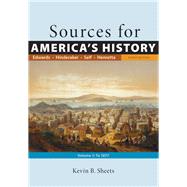Putting a human face on history, Sources for Americas History, Volume 1: To 1877 encourages you to develop historical thinking skills by providing between five and six sources per chapter that offer varying perspectives on a central theme, from well-known historical figures to everyday people living during that period.








